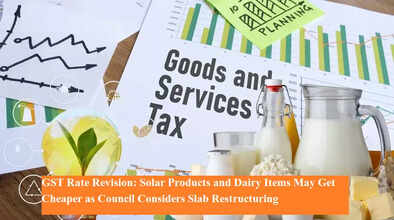GST Rate Revision: Solar Products and Dairy Items May Get Cheaper as Council Considers Slab Restructuring

The Goods and Services Tax (GST) Council is preparing for a significant rate restructuring that could directly benefit consumers across the country. In its upcoming meeting scheduled for September 3–4, 2025, the Council is expected to deliberate on scrapping the 12% GST slab, shifting products currently taxed under this category either to 5% or 18%. If implemented, this change will make several essential items, particularly solar energy equipment and dairy products, more affordable for households.
Solar and Renewable Energy Components Likely to Get Relief
The government has been working on measures to boost renewable energy adoption, and reducing GST on solar products is one such step. At present, items like solar cells, panels, inverters, street lights, water heaters, pumps, batteries, transformers, and cables attract GST rates ranging from 12% to 18%. Under the new proposal, all these products may soon be taxed at just 5%.
This move is expected to lower the cost of setting up solar systems for households, businesses, and farmers, thereby encouraging wider use of clean energy. Experts believe the revision will not only help consumers save money but also accelerate investments in the green energy sector, aligning with India’s long-term renewable energy goals.
No Change for IT Devices
While solar components may see a tax cut, IT devices such as data loggers will continue to attract an 18% GST rate. According to government officials, the focus of this revision is primarily to promote green energy adoption and provide cost-effective solutions for everyday consumers, rather than restructuring technology-related components.
Dairy Products Could See Tax Relief
Apart from solar goods, the GST Council is also considering rate cuts on packaged dairy items. Currently, products like butter, ghee, paneer, and flavored milk fall under the 12% GST slab. If the proposal goes through, these will be shifted to the 5% slab, offering direct relief to households who purchase these daily essentials.
It is important to note that some dairy items, such as paneer and khoya (mawa), already fall under the 5% tax category and will remain unchanged. The proposed rate cut will specifically impact packaged variants that currently attract higher taxation.
Proposed GST Rate Changes at a Glance
| Product | Current GST | Proposed GST |
|---|---|---|
| Solar Cell | 12% | 5% |
| Solar Panel | 12% | 5% |
| Power Generating System | 12% | 5% |
| Inverter | 12% | 5% |
| Solar Water Heater | 12% | 5% |
| Solar Street Light | 12% | 5% |
| Solar Pump | 12% | 5% |
| Solar Cables | 12% | 5% |
| Solar Battery | 12% | 5% |
| Transformer | 12% | 5% |
| Butter | 12% | 5% |
| Ghee | 12% | 5% |
| Paneer (packaged) | 12% | 5% |
| Flavoured Milk (packaged) | 12% | 5% |
Consumers and Farmers to Benefit
If the Council approves the proposal, the impact will be twofold. For consumers, everyday items like butter, ghee, and milk products will become more affordable, easing household expenses. On the other hand, farmers and the dairy industry could benefit from increased demand, leading to better income opportunities.
The renewable energy sector also stands to gain significantly. Lowering GST on solar products will reduce installation costs, making solar systems more accessible to rural households, small businesses, and farmers. This could, in turn, support the government’s mission of expanding India’s green energy footprint.
A Festival Season Relief?
Prime Minister Narendra Modi had earlier announced during his Independence Day address that citizens would see GST-related relief before Diwali. With the Council meeting set just weeks before the festive season, consumers are hopeful that these changes will be approved quickly, offering financial relief ahead of high-spending months.
Final Word
The proposed GST restructuring marks a crucial step toward balancing consumer relief with industry growth. If approved, it will not only make essential dairy and solar products more affordable but also encourage sustainable energy adoption and improve farmers’ earnings. All eyes are now on the GST Council’s September meeting, where the final decision will be made.

